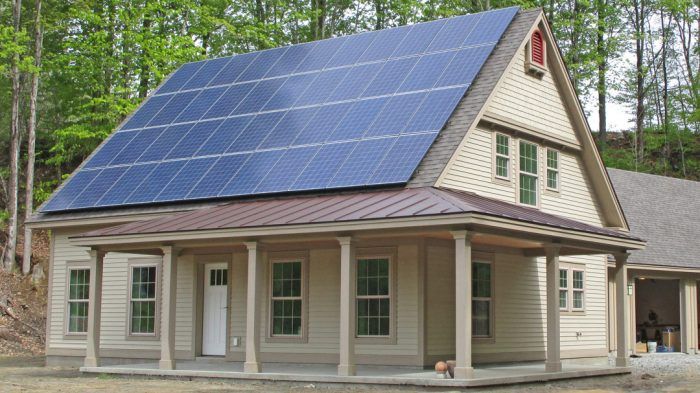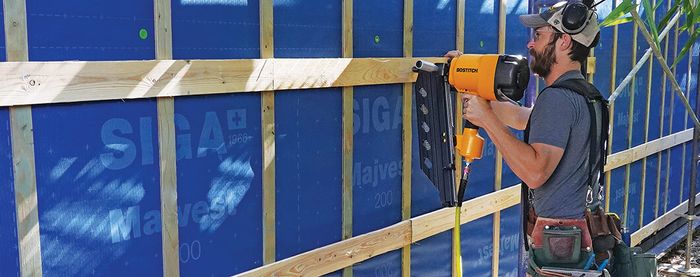Revisiting Net Zero Energy
With PV panel prices continuing to drop, does it make the most sense to invest in solar, add more insulation, or do both when building an energy-efficient home?

An 6-kW photovoltaic (PV) system can be installed for about $18,000 in many U.S. locations. With a 30% federal tax credit, the system costs the homeowner only $12,600 — or even less if utility or state rebates are available.
This 6-kW system will produce about 8,000 kWh per year in Boston (worth about $1,600) or 10,300 kWh per year in Phoenix (worth about $1,230). That’s a lot of electricity.
If you want to save between $1,200 and $1,600 per year on your heating or air conditioning bill, and you are willing to invest up to $12,600 to make it happen, you’ll probably find that adding insulation or new windows won’t get you to your goal. However, adding a PV system will.
Back in late 2006, when a Habitat for Humanity house in Wheat Ridge, Colorado, became the first house in the U.S. to achieve 12 months of net-zero-energy use, the net-zero goal was challenging. Eleven years later, the net-zero-energy goal is routinely achieved by builders all over North America. That’s because designing and building a net-zero energy house is becoming easier and easier.
Less expensive PV means a less expensive thermal envelope
The usual way to design a net-zero-energy house is to stop improving the thermal envelope of the house when the envelope improvements cost more per unit of energy saved than an investment in a bigger PV system.
In 2007, installing 1 kW of PV cost about $8,500. These days, the same PV system costs only $3,000 or $3,500. As the price of PV drops, investments in envelope improvements make less and less sense. Why upgrade to triple-glazed windows when the windows won’t save as much energy as an equivalent investment in PV?
With less expensive PV, today’s optimized net-zero-energy home will have a thermal envelope that performs worse and costs less to build than the optimized net-zero-energy homes of five years ago. Is this cause for celebration or cause for alarm?
The answer depends on your perspective. One way of examining this issue is to consider two opposing arguments in turn.
Argument #1: A less expensive thermal envelope is good news
Net-zero-energy homes only make sense in areas where the local utility offers a net-metering agreement to residential customers. If the utility offers a decent net-metering contract, and the homeowners meet their net-zero energy budget, then the cost of their electricity will be zero dollars per year, plus twelve times the monthly minimum charge that utilities tack onto every electricity bill. That’s a pretty good deal.
The typical net-metering contract won’t pay homeowners for extra electricity fed into the grid. So designers of net-zero homes try to install a PV system that produces enough electricity on an annual basis to meet, but not exceed, the homeowners’ annual electricity use.
In the old days, a net-zero energy house (especially one in a cold climate) often needed R-40 walls, R-60 ceilings, and triple-glazed windows. These features were expensive, but they were the only way to reduce energy costs to the point that the home’s energy needs could be cost-effectively met with a PV array.
Now that the cost of PV is half of what it used to be, the thermal envelope of a net-zero home doesn’t have to be as expensive. The average net-zero home may be able to choose envelope features that cost $10,000 less — and meet the increased energy needs of the home with $5,000 in extra PV modules.
The result is a net-zero-energy house that is more affordable. As these homes become more affordable, more Americans will want to own one. That allows the net-zero snowball to keep growing.
Specifying thicker insulation than needed to make the house net-zero requires the designer to ignore cost-effectiveness. The only reason to ignore cost-effectiveness is if the additional investment serves an important purpose — for example, aesthetics or comfort. Absent such a purpose, what’s the point of spending more than necessary to meet your design goals?
Argument #2: It’s good to specify a better thermal envelope than the net-zero approach calls for
The counterargument — that is, the argument favoring thermal envelopes that save more energy than required by the net-zero approach — rests on six legs:
- A high-performance thermal envelope can be more comfortable than an envelope with lower R-values.
- A high-performance thermal envelope is more resilient (less likely to freeze during an extended power outage).
- The net-zero approach doesn’t take the expected service life of components into account; since most types of insulation last longer than most PV systems, this failure to consider the service life of components skews the analysis.
- During cloudy weather, net-zero homes depend on grid electricity; in light of the climate crisis, we are all duty-bound to reduce our energy use to very low levels, even if we own a large PV system, in order to reduce demands on the grid. (Another way of phrasing this point: A kWh fed into the grid on an April afternoon isn’t equivalent — from either an economic or an environmental perspective — to a kWh drawn from the grid on a December night.)
- The most efficient way to add PV capacity to the grid is with large utility-owned PV installations rather than with small PV systems owned by homeowners.
- In the future, utilities may renege on net-metering promises, leaving owners of PV systems in the lurch. When that happens, owners of homes with high-performance thermal envelopes will have the last laugh.
Many proponents of the Passive House approach make the six points I’ve just listed. All six points are debatable.
Is the net-zero goal a low bar or a high bar?
My instincts tend to favor the net-zero-energy approach to home design. It’s a practical approach that aligns well with the “pretty good house” philosophy.
That said, it’s important to acknowledge (as I freely do) that the net-zero design approach results in shifting goal posts. The optimal R-value of our thermal envelopes is dropping. How low should we go?
Clearly, the bar can’t be lowered beyond minimum code requirements. In many areas of the country, minimum code requirements, executed well, are fairly close to optimum for a net-zero house.
If we look several decades ahead, it’s possible to envision a future in which our grid electricity is both inexpensive and generated from 100% renewable sources. We’re not there yet, of course, and we may never reach that promised land. But if we ever get there, we’ll all have fewer reasons to save energy than we do now.
Originally published on GreenBuildingAdvisor.com. Image Credit: Martin Holladay.
Martin Holladay’s previous blog: “The Exterior Rigid Foam is Too Thin!”





